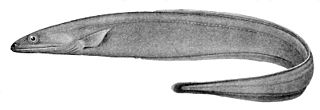
Leptocephalus is the flat and transparent larva of the eel, marine eels, and other members of the superorder Elopomorpha. This is one of the most diverse groups of teleosts, containing 801 species in 4 orders, 24 families, and 156 genera. This group is thought to have arisen in the Cretaceous period over 140 million years ago.

Ophichthidae is a family of fish in the order Anguilliformes, commonly known as the snake eels. The term "Ophichthidae" comes from Greek ophis ("serpent") and ichthys ("fish"). Snake eels are also burrowing eels. They are named for their physical appearance, as they have long, cylindrical, snake-like bodies. This family is found worldwide in tropical to warm temperate waters. They inhabit a wide range of habitats, from coastal shallows and even rivers, to depths below 800 m (2,600 ft). Most species are bottom dwellers, hiding in mud or sand to capture their prey of crustaceans and small fish, but some are pelagic.

Synaphobranchus is a genus of eels in the cutthroat eel family, Synaphobranchidae. It currently contains the following species:
Gnathophis is a genus of marine congrid eels.
Mastacembelus is a genus of many species of spiny eel fish from the family Mastacembelidae. They are native to Africa and Asia. Most are found in rivers and associated systems, but there are also species in other freshwater habitats and a particularly rich radiation is found in the Lake Tanganyika basin with 15 species. A few species can even occur in brackish water.

Heteroconger is a genus of marine congrid eels. These small, slender garden eels live in groups where each individual has its own burrow. Usually, only the head and front half of the body is visible. The greatest species richness is in the Indo-Pacific, but species are also found in the warmer parts of the Atlantic and the eastern Pacific. Its name relates to how a huge colony of the eels looks swaying in the current.

Histiobranchus is a genus of eels in the family Synaphobranchidae.

The Colocongridae, the worm eels or short-tail eels, are a family of eels, containing a single genus, Coloconger.
Myroconger is the only genus of eels, the thin eels, in the family Myrocongridae. Very little is known about the group.

Eels are ray-finned fish belonging to the order Anguilliformes, which consists of eight suborders, 20 families, 164 genera, and about 1000 species. Eels undergo considerable development from the early larval stage to the eventual adult stage and are usually predators.
Neoconger is a small genus of eels of the family Moringuidae. It contains these described species:
Bathycongrus is a genus of eels in the family Congridae.

The garden eels are the subfamily Heterocongrinae in the conger eel family Congridae. The majority of the 36 known species of garden eels live in the Indo-Pacific, but can be found in warm ocean water worldwide. These small eels live in burrows on the sea floor and get their name from the behavior of poking their heads from their burrows while most of their bodies remain hidden. Since they tend to live in groups, the many eel heads "growing" from the sea floor resemble the plants in a garden. They vary in color and size depending on the species. The largest species reaches about 120 cm (47 in) in length, but most species do not surpass 60 cm (24 in). Garden eel colonies can grow as large as one acre in surface area and number up to several thousand individuals.

Callechelys is a genus of eels in the snake eel family Ophichthidae. It currently contains the following fifteen species:

Dalophis is a genus of eels in the snake eel family Ophichthidae. It currently contains the following species:

Quassiremus is a genus of eels in the snake eel family Ophichthidae. It currently contains the following species:
Benthenchelys cartieri is an eel in the family Ophichthidae. It was described by Henry Weed Fowler in 1934. It is a tropical, marine eel known from the Philippines, in the western central Pacific Ocean. It is known to dwell at a maximum depth of 1168 m, and inhabits the pelagic zone.
Benthenchelys pacificus is an eel in the family Ophichthidae, described by Peter Henry John Castle in 1972, originally as a subspecies of Benthenchelys cartieri. It is a marine, deep-water-dwelling eel known only from its type locality in the eastern central Pacific Ocean. It inhabits the pelagic zone.
The deepwater big-eyed worm eel is an eel in the family Ophichthidae. It was described by John E. McCosker in 2006. It is a subtropical, marine eel which is known from New Zealand, in the southwestern Pacific Ocean. It dwells at a depth range of 425–820 metres. Females can reach a maximum total length of 58 centimetres.










